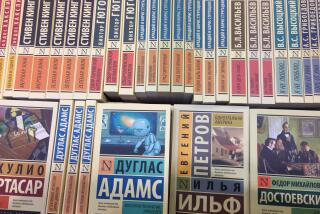Soviet Scholars’ Charm Warms Young Friends : Visitors Offer Advice to Pupils in Stop to Dedicate Exhibit
- Share via
Mikhail S. Gorbachev isn’t the only Soviet citizen who can charm an American crowd.
On Thursday eight Soviet scholars--as charismatic as their premier--smiled, talked and sang their way into the hearts of about 500 students during a two-hour visit to Viewpoint School in Calabasas.
“They don’t look like Russians, they look like grandparents,” 5-year-old Justin Marangas said of the Soviet academics, who are in Los Angeles for the opening of a Museum of Natural History exhibit on nomads of the Eurasian steppes.
The Soviet visitors acted like grandparents too--lavishing hugs, kisses, gifts and friendly advice on the students.
“You must study good,” Rudolf Its, director of the Soviet Academy of Science’s Institute of Ethnography, admonished a ninth-grade biology class during a tour of the school. “Your future and our future is in your hands. Come study at my university. There is a difficult exam to come, but I’ll help you.”
Advice to Students
“All of us should have a good knowledge of history,” Vladimir Basilov, also of the institute, advised the student body in perfect English during an assembly. “History repeats itself again and again, and the better we know history, the better we can arrange our lives.”
When presented with gifts and school medallions from students, the Soviet visitors were unabashedly affectionate, turning students’ handshakes into big bear hugs. The professors delighted the audience by singing a popular Russian children’s song for peace and by giving solo performances of regional folk songs.
Then, at the suggestion of Basilov, all joined in a boisterous round of “When the Saints Go Marchin’ In.” At the end, the Soviet visitors presented school officials with a painted porcelain samovar, a traditional Russian urn used to boil water for tea.
Students at the private school, who range from kindergarten through grade 12, were exuberant after the assembly.
Alona Berger, a seventh-grader whose mother and grandmother are Russian immigrants, said she was thrilled by her opportunity to welcome the guests in their native tongue. “It was really neat but really scary,” she said. “I was shaking the whole time.”
Most students, however, said they were excited because it was their first experience with “real Russians.”
“They were so nice, so kind,” said 12-year-old Rebecca Ba’Gah. “We hear these bad things, but they are good. It was neat to have Russians and Americans together, united.”
Occasion for Tears
Kristin Lane, a 12-year-old seventh-grader, said she was so overwhelmed by the visitors’ warmth that she cried. “It was so nice that we could be friends and appreciate each other.”
For the Soviet scholars, the outpouring of affection appeared to come naturally.
“I don’t think that I can find the words to explain how happy we are,” Basilov told the students. “It is so nice to find that we, the Russians, and you, the Americans, can be together, can coexist as good friends.”
The visit seemed to demonstrate that despite cultural and political differences, some things are universal.
Irina Semashko, also an ethnographer, noted that “our children are like American children, very gay and very hospitable--especially the small ones. Even the uniforms are similar, the same color.”
“I must say that your boys and your girls are the same as my grandsons and my granddaughters. The youngest, yes, and the oldest, well, they like those rock groups,” Its said, shrugging.
More to Read
Sign up for The Wild
We’ll help you find the best places to hike, bike and run, as well as the perfect silent spots for meditation and yoga.
You may occasionally receive promotional content from the Los Angeles Times.






